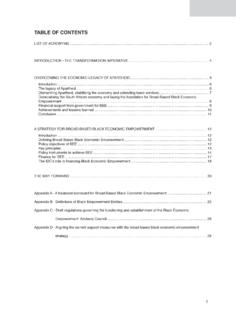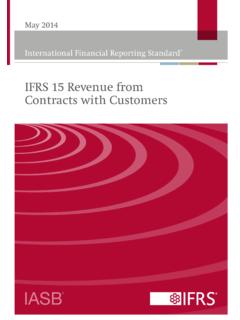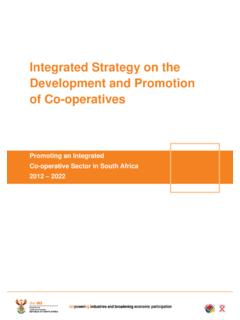Transcription of The path to technology commercialisation A5 FINAL
1 GUIDE FOR SOUTH AFRICAN technology -BASED ENTERPRISES, RESEARCHERS AND INNOVATORS towards full-scale industrialisation and inclusive growththe dti Customer Contact Centre: 0861 843 384 the dti Website: PATH TO technology commercialisation The Department of Trade and Industry (the dti), September 2016 Photos are royalty-free stock images, courtesy of the dti Photo dti Campus77 Meintjies StreetSunnysidePretoria0002the dtiPrivate Bag X84 Pretoria0001the dti customer contact centre: 0861 843 384the dti website: the dti 3 ContentsFOREWORD BY THE MINISTER OF TRADE AND INDUSTRY ..4 ABBREVIATIONS AND ACRONYMS ..5 TERMS GLOSSARY ..5 THE PROCESS OF COMMERCIALISING technology ..8 CONCEPT PHASE ..101 Proof of concept ..102 Market-needs assessment.
2 113 Venture assessment ..114 Disclosure of invention ..12 WHAT SHOULD YOU CONSIDER IF YOUR INVENTION WAS PUBLICLY FUNDED? ..12 DEVELOPMENT AND PRE- commercialisation PHASE ..135 Technical feasibility ..136 Market study ..147 IP evaluation ..148 Economic feasibility ..15 DECISION: SELECTION OF PATH TO COMMERCIALISE PRODUCT/SERVICE ..16 OPTION A: STARTUP OR EXISTING COMPANY ..17 DEVELOPMENT AND PRE- commercialisation PHASE ..17A1 Engineering prototype ..17A2 Marketing plan ..18A3 Business plan ..18A4 IP protection application ..19A5 Preproduction prototype (pilot) ..19A6 Market validation ..20A7 Business formation ..20 commercialisation PHASE ..21A8 Production ..21A9 Market monitoring ..22A10 Business growth.
3 22A11 Product support ..23A12 Market diversification ..23 PARTNERSHIPS ..24 OPTION B: LICENSING OR ASSIGNMENT OF IPR ..24 PRE- commercialisation AND DEVELOPMENT PHASE ..24 commercialisation PHASE ..24B1 IP protection application ..25B2 technology marketing ..25B3 Licensing or assigning IPR ..26 WHAT TO KEEP IN MIND WHEN LICENSING? ..26 Good Luck ..27 Annexure 1: technology Readiness Levels ..28 Annexure 2: Comparative Analysis of Preferred commercialisation Paths ..29 Annexure 3: Sources of Funding ..30 Annexure 4: Sources of Non-Financial Support ..31 Annexure 5: Government Departments and Agencies ..32 Annexure 6: Selected Public Knowledge Generators ..334 The path to technology commercialisationFOREWORD BY THE MINISTER OF TRADE AND INDUSTRYIn a highly competitive global environment, new technologies play a crucial role in maintaining and even improving South Africa s competitiveness, particularly in sectors such as manufacturing and mining, which can absorb larger numbers of unskilled or semi-skilled workers.
4 Thus the dti is continuing with its efforts to nurture and support innovative fi rms, especially in those labour-intensive sectors that make up a signifi cant percentage of the South African reviews of the technology and Human Resources for Industry Programme (THRIP) and Support Programme for Industrial Innovation (SPII) have brought realisation that technology development is not an end result, but technology must create an economic value through proliferation and commercialisation . technology commercialisation is critical in supporting industrialisation and diversifying our economy through the creation of new industries. Although the technology commercialisation concept sounds appealingly simple, the implementation can present complexities that inventors and researchers had not anticipated.
5 Therefore, the aim of the guide is to enable users to minimise complexities and help them bring the country s innovations to industry and the wider community for societal and economic guide outlines the key steps that are involved in the commercialisation process, from idea generation to market development once the product or process has entered the market. Depending on the industry, research institution, size of the fi rm, type of innovation, the market conditions and many other aspects, the path followed will need to fi t the reality of each fi rm, entrepreneur or researcher as well as refl ect individual circumstances and market it is not plausible to provide and include all the necessary steps and answers needed by users in the technology commercialisation process, the guide does aim to equip them with concepts, activities and milestones essential for commercialising new technologies and to accelerate the transfer of innovations developed in knowledge-based institutions to Rob Davies (MP)
6 Minister of Trade and Industrybased institutions to the dti 5 ABBREVIATIONS AND ACRONYMSBBBEE Broad-Based Black Economic EmpowermentCIPC Companies and Intellectual Property Commission HEI Higher Education InstitutionIP Intellectual Property IPR Intellectual Property Rights MCEP Manufacturing Competitiveness Enhancement Programme NDA Non-Disclosure Agreements NIPMO National Intellectual Property Management OfficeOECD Organisation for Economic Cooperation and DevelopmentOTT Office of technology TransferR&D Research and Development SAVCA Southern African Venture Capital and Private Equity AssociationSMME Small, Medium and Micro-sized EnterpriseSPII Support Programme for Industrial InnovationSTP SEDA technology Programme TIA technology Innovation AgencyTRL technology Readiness LevelTVC technology Venture CapitalWIPO World Intellectual Property OrganisationTERMS GLOSSARYA ngel investor Angel investors are usually wealthy individuals who invest their money in entrepreneurial companies, unlike venture capitalists, who invest other people s money.
7 Angel investments are typically the earliest equity investments made in start-up companies. They are often former entrepreneurs themselves, and typically enjoy working with start-up companies and provide valuable expertise. commercialisation commercialisation is the process of introducing a new product, service or process into the market with the purpose of deriving revenue. The launch of a new product is the FINAL stage of product development, where funds are spent primarily on advertising, sales promotion, and other marketing Copyright is the legal right granted to an author, composer or publisher to exclusive publication, production, sale or distribution of software, or a literary, musical, dramatic or artistic the internet as a medium, crowdfunding is an open appeal for funds made to the general public in support of specific projects.
8 In the context of technology commercialisation , crowdfunding can be a useful tool to raise additional funds for inventors or entrepreneurs during the technology -development and commercialisation capital (pre-revenue)/Series BFinance used after startup capital/early stage funding to push the business further and expand market share to become financing Debt financing involves borrowing money with a promise to repay the amount borrowed, plus interest. Sources of debt financing include banks and savings and loan institutions; angel investors; venture capitalists; and personal loans from family, friends or other The path to technology commercialisationEquity financing Equity financing refers to raising funds for business purposes by trading complete or partial ownership of a company s equity for money or other assets.
9 Venture capital is one of the more popular forms of equity financing used to finance high-risk, high-return entrepreneurThis expression comes from famous entrepreneurs who have started their companies in their garages. Garages serve as early workshops for the development of the products, services or processes on which the company will be based. More generally, the term refers to entrepreneurs who develop their new or significantly improved product outside of an organisation or structure such as a university, science council or inventionGrassroots inventions are solutions developed locally using local resources and capabilities to improve livelihoods and promote sustainability. Growth capital (post-revenue)Growth capital is an equity-type investment in a relatively established but still high-risk venture, and is specifically used to expand a firm s (technological)Innovation refers to the introduction of a new or significantly improved product or process to the market.
10 It also refers to an invention that has reached the market. Intellectual property (IP)Any creation of the mind such as inventions; literary or artistic works; designs; or symbols, names and images used in commerce. Intellectual property rights (IPR)IPR refers to independent assets that can be sold (assigned) or licensed to third parties. This includes patents as well as non-registered rights such as refers to a product, process or technique that displays some degree of novelty. In some circumstances, legal protection may be granted to an Act The Intellectual Property Rights from Publicly Financed Research and Development Act, 2008 (Act No. 51 of 2008), referred to as the IPR Act, was promulgated on 2 August 2010. It provides for the effective identification, protection, utilisation and commercialisation of publicly funded IP.













